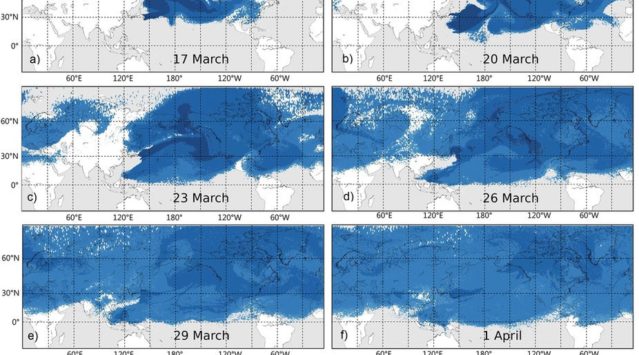JUNGMIN KANG
NOVEMBER 30, 2017
I. INTRODUCTION
In this essay, Jungmin Kang estimates inventories of radioactive material in spent fuel pools in South Korea that might be attacked by terrorists. He analyses radiological plumes under prevailing winds at different seasons. He concludes that: “Cooperation among relevant countries in the region to reduce the risk of SFPF might include the following measures: a) Design basis threat (DBT) on SFP and Force-on-force tests; and b) Radiation emergency preparedness and public information regulations.”
Jungmin Kang, scientist at the Natural Resources Defense Council
Paper prepared for Workshop Reducing Risk of Nuclear Terrorism and Spent Fuel Vulnerability in East Asia co-sponsored by Nautilus Institute and Research Center for the Abolition of Nuclear Weapons, Nagasaki University, Nagasaki, January 20-22, 2017
The views expressed in this report do not necessarily reflect the official policy or position of the Nautilus Institute. Readers should note that Nautilus seeks a diversity of views and opinions on significant topics in order to identify common ground.
Banner image: Modelled 131I activity concentrations in the troposphere (0–10,000 m) on the 6th, 9th 12th, 15th, 18th and 21st days after the initial release from Fukushima, from here.
II. NAPSNET SPECIAL REPORT BY JUNGMIN KANG
VULNERABILITY TO TERRORISM OF NUCLEAR SPENT FUEL: THE SOUTH KOREAN CASE
NOVEMBER 30, 2017
Status and Prospects of Nuclear Power
One of the most rapidly growing developed countries in the world today, South Korea has been increasingly relying on nuclear power since 1978, when it started its first commercial nuclear power plant. Figure 1 shows the past and expected growth in installed nuclear capacity through 2035.[1]
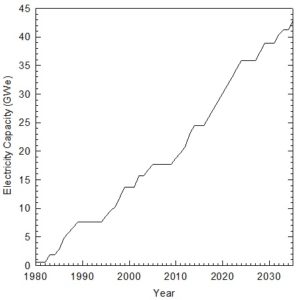
Figure 1. Installed nuclear generation capacity in the ROK (1980-2035)
Table 1 and 2 show power reactors in operation and under construction or planned, respectively, in South Korea. All of the nuclear power plants in South Korea are located along the coast of the peninsula, as shown in Figure 2. On September 14, 2012, the Ministry of Trade, Industry and Energy (MOTIE) announced that Yeongdeok and Samcheok both located on the East coast have been identified as new sites for nuclear power plants.[2]
Table 1. Power reactors in operation[3]

Table 2. Power reactors under construction or planned[4]
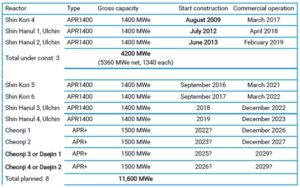
National Policy on Spent Fuel Management
At its 253rd meeting in 2004, the Korean Atomic Energy Committee (AEC) announced that a national policy for spent fuel management would be decided later in consideration of progress of domestic and international technology development, and that spent fuel would be stored at reactor sites through 2016 under KHNP’s authority.[5]
Since then, South Korea has not decided the spent fuel management policy till May 25, 2016 when the MOTIE firstly announced a national plan on the spent fuel management, based on recommendations by the Public Engagement Commission on Spent Nuclear Fuel Management (PECOS), an independent advisory body that was established in October 2013, in June 2016.[6]
The main substance of the national plan is as follows.[7]
- Government plans to build a geologic disposal site to be operational in 2053. To do this, it is scheduled for government to select site for an Underground Research Laboratory (URL) at the disposal site by 2028, to construct the URL and to do empirical study till 2042.
- An interim storage facility is to be built at the disposal site by 2035, to store spent fuel until operation of disposal site. If unavoidable, spent fuel would be stored at onsite temporary storage facilities till operation of the interim storage site begins. In addition, government would try to utilize an international spent fuel management facility for storage and disposition of spent fuel if available.
- R&D of reduction of volume and radiotoxicity of spent fuel would be continued.
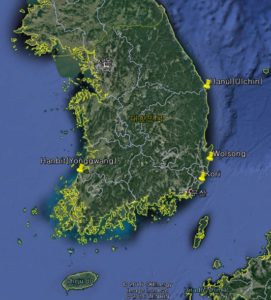
Figure 2. Satellite image of Korean peninsula indicating four NPP sites[8]
Status of Spent Fuel Generation
As of the end of 2015, 16,289 fuel assemblies of PWR spent fuel and 408,797 fuel bundles of CANDU spent fuel were stored in the spent fuel storage facilities at South Korea’s four NPP sites. Table 3 shows the spent fuel inventories at the four sites as of the end of 2015.[9]
Table 3. Inventory of spent fuel at NPP sites in South Korea as of the end of 2015
| Reactor | Reactor type | Annual spent fuel discharge (tHM) | Amount of SF in the Pool (tHM)[10] |
| Kori 1
Kori 2 Kori 3 Kori 4 Shin Kori 1 Shin Kori 2 |
PWR
PWR PWR PWR PWR PWR |
14.4
15.9 20.5 20.5 20.4 20.4 |
114
281 818 797 154 98 |
| Hanbit 1
Hanbit 2 Hanbit 3 Hanbit 4 Hanbit 5 Hanbit 6 |
PWR
PWR PWR PWR PWR PWR |
20.5
20.5 20.4 20.4 20.4 20.4 |
666
456 372 378 255 254 |
| Hanul 1
Hanul 2 Hanul 3 Hanul 4 Hanul 5 Hanul 6 |
PWR
PWR PWR PWR PWR PWR |
20.5
20.5 20.4 20.4 20.4 20.4 |
401
408 430 404 231 206 |
| Shin Wolsong 1
Shin Wolsong 2 |
PWR
PWR |
20.4
20.4 |
47
20 |
| Wolsong 1
Wolsong 2 Wolsong 3 Wolsong 4 |
CANDU
CANDU CANDU CANDU |
103.7
103.7 103.7 103.7 |
587.7
714.7 818.7 799.7 4908.0 (dry storage) |
Hazard of Spent Fuel
Spent fuel contains high level radioactive nuclides, including Cs-137. Cs-137 (a 30-year half-life) is a potent land contaminant because 95% of its decays are to an excited state of Ba-137, which de-excites by emitting a penetrating gamma ray. Approximately 0.1 MBq of Cs-137 is contained in the 1 tHM of 10-year cooled PWR spent fuel with burnup of 40 MWd/kgHM.[11] Cs-137 has forced the long-term relocation of population from large area by the April 1986 Chernobyl accident and the March 2011 Fukushima accident.
In the Chernobyl accident, about 2 Mega Curies (MCi) were released from the reactor. Strict radiation-dose control measures were imposed in areas contaminated to levels greater than 15 Ci/km2 (555 kBq/m2) of Cs-137. The total area of this radiation-control zone was 10,000 km2. More than 100,000 residents were evacuated.[12]
In the Fukushima accident, areas contaminated to levels greater than 27 Ci/km2 (1 MBq/m2) were adopted for relocation. The area of relocation was 1,100 km2. 88,000 residents were evacuated.[13]
Cooling Spent Fuel in the Pool
Spent fuel pools (SFP) are located in buildings adjoining the reactor containment buildings at NPP. PWR spent fuel assemblies are stored vertically at specific rack systems in the pool. The size of SFP is typically about 12 m deep and vary in width and length depending on a specific NPP (e.g., the size of SFP of Hanbit 5 & 6 is 7.4 m wide, 9 m long and 12 m deep[14]). Figure 3 shows diagram of a generic PWR spent fuel pool.
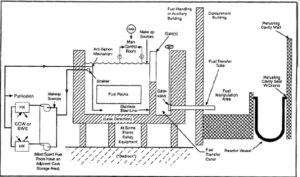
Figure 3. A diagram of a generic PWR spent fuel pool[15]
SFP water is cooled by a dedicated cooling system. As shown in Figure 3, water is pumped through heat exchangers where heat is transferred to an intermediate cooling system, which finally rejects heat to the plant’s ultimate heat sink.[16]
Low Density vs. High Density Spent Fuel Pool
Due to lack of storage capacity of pools onsite and an off-site destination for their accumulating spent fuel, nuclear-power plant operators have packed as many fuel assemblies as possible into their storage pools (see Figure 4a). The standard spacing for the high-density racks is 23 cm. This high-density racked fuel is kept sub-critical by enclosing each fuel assembly in a metal box whose walls contain neutron-absorbing boron.[17]
These boron-containing partitions would block the horizontal circulation of cooling air if the pool water were lost, greatly reducing the benefits of mixing recently-discharged with older fuel. During a partial uncovering of the fuel, the openings at the bottoms of the spent-fuel racks would be covered in water, completely blocking air from circulating up through the fuel assemblies.
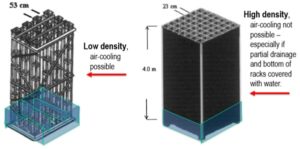
Figure 4a. Low density and high density PWR spent-fuel racks[18]
Hydrogen Explosion in High Density Spent Fuel Pool
Spent fuel pool accidents involving a loss of coolant have the potential for leading to significant fuel heat up and resultant release of fission products to the environment. Such an accident would involve decay heat raising the fuel temperature to the point of exothermic cladding oxidation, which would cause additional temperature escalation (leading to “zirconium fire”) to the point of fission product release.[19] Figure 4b illustrates SFPF.
Hydrogen is produced when the zirconium cladding of the spent fuel is uncovered and becomes hot in the presence of water vapor. US NRC staff found less hydrogen and explosion much less likely with low-density pool storage. If building stays intact, much less Cs-137 released to atmosphere.[20]
US NRC assumes the range of SFP release fractions as show in Table 4 for PWR.
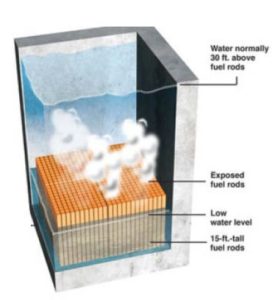
Figure 4b. Spent fuel pool partial drainage and zirconium fire[21]
Table 4. Estimated cumulative cesium inventory release fraction given a PWR SFPF[22]
| SFP loading | Low case | Base case | High case |
| High-density | 10% | 75% | 90% |
| Low-density | 0.5% | 3% | 5% |
Scenarios of Terrorists Attack on Spent Fuel
Potential scenarios that can lead to loss of spent fuel cooling caused by loss of cooing water inventory sufficient to interrupt heat transfer to the cooling system or result in uncover of the fuel and by failure of cooling system pumps and heat exchangers to transfer heat from the pool to the ultimate heat sink.
A 2006 NAS report considered four classes of terrorist attack scenarios:[23]
- Air attacks using large civilian aircraft or smaller aircraft laden with explosives,
- Ground attacks by groups of well-armed and well-trained individuals,
- Attacks involving combined air and land assaults, and
- Thefts of spent fuel for use by terrorists (including knowledgeable insiders) in radiological dispersal devices.
Loss of coolant scenarios described by UK POST in 2004
A 2004 UK Parliamentary Office of Science and Technology describes ways in which loss of coolant could occur from a pool due either to an accident or to sabotage as followings.[24]
- Evaporation: if the cooling systems which extract heat from the cooling water were damaged, the temperature of the cooling water would rise, leading to evaporation. This would take place very slowly and it would probably be several days or weeks before the fuel elements were exposed to air, thus allowing time for remedial action to be taken.
- Drainage: this could occur through damage to the network of pipes or tubes connecting the pool to other areas. This would take place more rapidly than first scenario but it is reasonable to assume that there would be a variety of options available for operator intervention before the water level fell below the level of the fuel.
- Severe damage to the pond walls or floor – e.g. due to aircraft crash or dropping of a heavy load. This could result in rapid drainage of water from the ponds.
A Case Study of Fukushima SFPF Accident
Although there was no spent fuel pool fire at the Fukushima Daiichi Nuclear Power Plant, TEPCO learned that the catastrophe had been avoided by a lucky break detailed in a report released by the U.S. National Academies of Sciences, Engineering, and Medicine in 2016 about the lessons learned from the Fukushima nuclear accident.
Frank von Hippel and Michael Schoeppner analyzed the hypothetical fire of the Fukushima spent fuel pool #4 using using the U.S. National Oceanic and Atmospheric Administration’s (NOAA’s) HYSPLIT model,[25] which uses meteorological data archived in NOAA’s Global Data Assimilation System. Figure 5 shows the areas of Japan contaminated to more than 1 MBq/m2 by the actual accident, which released in the range of 6–20 PBq and by hypothetical 4-day releases of 890 PBq beginning on 9 April and 19 March 2011, respectively. The compulsory relocation zone shown on the right of Figure 5 could extend to 31,000 km2 that covers about 8% of Japan’s land area, including 27% of the population of Japan or 35 million people.[26]
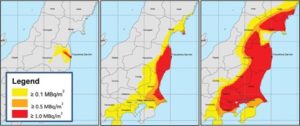
Figure 5. Contamination levels after the hypothetical fire of the Fukushima spent fuel pool #4
A Case Study of Kori-3 SFPF Accident
Kori-3 pool with high-density rack contains approximately 818 tHM of spent fuel as of the end of 2015. Figure 6 to 8 show three results of contamination levels after the hypothetical fire of Kori-3 pool. Source term of the PWR spent fuel were calculated by Jungmin Kang using ORIGEN2 code[27] while Michael Schoeppner performed the dispersion and deposition simulations using HYSPLIT code with historic weather data of the first day of every month in 2016 surrounding Kori. We assume release of 1,600 PBq Cs-137 for 3 days.
Table 5 shows the summarized results of the Kori-3 SFPF accident. For example, for South Korea, average and maximum compulsory area are 9,000 km2 and 54,000 km2, respectively, while average and maximum number of evacuated people are 5.4 million and 24.3 million, respectively.
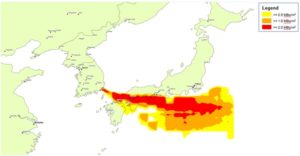 Figure 6. Contamination levels after the hypothetical fire of Kori-3 pool using weather data on Jan 1, 2015
Figure 6. Contamination levels after the hypothetical fire of Kori-3 pool using weather data on Jan 1, 2015
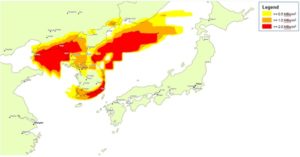
Figure 7. Contamination levels after the hypothetical fire of Kori-3 pool using weather data on Apr. 1, 2015
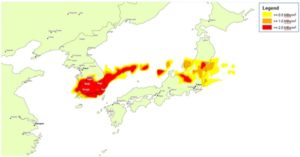
Figure 8. Contamination levels after the hypothetical fire of Kori-3 pool using weather data on Sep. 1, 2015
Table 5. Summarized results of the Kori-3 SFPF accident
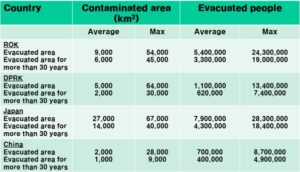
How to Reduce the Risk of SFPF
Including Jungmin Kang, authors of a 2003 S&GS paper have proposed a number of possible actions to correct for the obvious vulnerabilities of spent fuel pools and to reduce the worst- case release that can occur from such pools, as summarized in Table 6.[28]
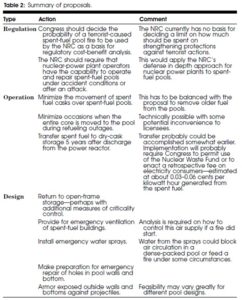
Table 6. Summary of proposal to reduce the risk of SFPF
The Role of Regional Cooperation
Cooperation among relevant countries in the region to reduce the risk of SFPF might include the following measures:
- Design basis threat (DBT) on SFP and Force-on-force tests
- Radiation emergency preparedness and public information regulations
II. ENDNOTES
[1] Ministry of Trade, Industry and Energy (MOTIE), The 2nd National Energy Basic Plan, January 2014 (Korean); MOTIE, The 7th Basic Plan for Long-Term Electricity Supply and Demand (2015 ~ 2029), July 2015 (Korean).
[2] Kim So-hyun, “Samcheok, Yeongdeok new sites for nuke plants,” The Korea Herald, Dec 23, 2011, http://www.koreaherald.com/view.php?ud=20111223000618
[3] World Nuclear Association, “Nuclear Power in South Korea (Updated December 2016),” http://www.world-nuclear.org/information-library/country-profiles/countries-o-s/south-korea.aspx (accessed January 10, 2017).
[4] Ibid.
[5] Press Release, 253rd meeting of Korean AEC in 2004, December 17, 2004 (Korean).
[6] IPFM BLOG, “Advisory group recommends building dry storage facility in South Korea,” June 15, 2015;The commission recommendations are as follows.
- The top priority of spent fuel management is public safety. Spent fuel should be managed safely and effectively under government responsibility. Selected spent fuel management technologies should be proven by the experts. The results of technological application should not be an excessive burden for future generations.
- It should be made a rule to move spent fuel to reliable storage facilities before temporary storage capacity is exceeded or the operating permit of temporary storage facilities expires.
- Government should build a final geologic disposal site to be operational in 2051. To do this, it is desirable for government to select site for an Underground Research Laboratory (URL) at the disposal site or at a site with similar geologic characteristics by 2020, to construct the URL till 2030, and to do empirical study after 2030.
- With resident participation, an environmental radiation supervisory center (tentative) would be established at the final geologic disposal site and a site for URL. Paying for local communities is recommended to improve the quality of life and to improve a stable economic base for the communities that host the final geologic disposal site and the site for URL. First, it would create new jobs and vitalize local economy by locating related organizations of spent fuel research and management. Second, it would pay municipalities for the disposal of spent fuel. Third, it would help conserve the local communities’ natural environment and establish urban development plans for the local communities with a special subsidy.
- A pre-disposal stage storage facility is to be built at URL site, which would be selected in 2020, to store NSF until operation of disposal site. If unavoidable, spent fuel would be stored at onsite temporary storage facilities till operation of disposal site begins. In addition, close cooperation between the countries would be required to prepare an international spent fuel management facility.
- If temporary storage facilities are built within NPP site to store spent fuel, “NSF storage fee” is to be paid to localities. A Resident Foundation (tentative) shall be established and run at each NPP region in order to ensure transparent and efficient collection and management of “NSF storage fees.” It is also necessary for government and NPP hosting regions to negotiate in detail on the payment of reasonable fee for spent fuel currently stored at each NPP site.
- It is necessary to prioritize the technologies for storage, transportation, disposal, and for the reduction of volume and toxicity of spent fuel, as well as to set up and execute a detailed plan for the development of such technologies. We should establish, above all, standard for control. We should also set up an institutional mechanism and operate an integrated system for experts from various disciplines to initiate technology development with social responsibility.
- It is highly desirable to secure safety, responsibility, stability, efficiency, and transparency in spent fuel management. For this, we advise to establish NSF Technology and Management Corporation (tentative) in which government, utilities, and the public co-own the stake and share the responsibility for technology development and phased management.
- It is necessary to enact Special Law on NSF (tentative) or amend existing laws and regulations as soon as possible in order to provide transparency, stability and sustainability in spent fuel management as well as to uphold credibility of the spent fuel policy.
- In order to set up and execute spent fuel management policy immediately, an inter-ministry decision-making body (NSF Planning Committee) and its working-level executive arm (NSF Policy Implementation Committee) are to be set up and operated within the government.
[7] Korean Atomic Energy Commission, “Draft Plan for the High Level Radioactive Waste Management,” July 25, 2016 (Korean).
[8] Google Earth Pro, Nov 29, 2016.
[9] Atomic Energy Commission, “Draft Basic Plan of High-Level Radioactive Waste Management,” Jul. 25, 2016 (Korean). Kang estimates that weights of 16,289 fuel assemblies of PWR spent fuel and 408,797 fuel bundles of CANDU spent fuel are approximately 6,760 tHM and 7,849 tHM, respectively.
[10] Because of lack of spent fuel pool capacities, some spent fuel have been transported between pools on the same site. See below. Yongdeog Kim, “Spent Nuclear Fuel Management Activities in Korea,” International Workshop on Preparation for and Management of Decommissioning for aging NPPs, Sept. 10-12, 2015, Hanyang University, South Korea.
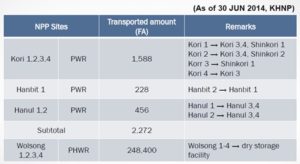
[11] Calculated using the ORIGEN 2 computer code [Oak Ridge National Laboratory, “ORIGEN 2.1: Isotope Generation and Depletion Code Matrix Exponential Method, CCC-371 ORIGEN 2.1, August 1996].
[12] R. Alvarez et al, “Reducing the Hazards from Stored Spent Power-Reactor Fuel in the United States,” Science and Global Security, 11:1–51, 2003.
[13] Frank von Hippel and Michael Schoeppner, “Reducing the Danger from Fires in Spent Fuel Pools,” Science and Global Security, 24:141–173, 2016.
[14] Jungmin Kang, “Alternatives for Additional Spent Fuel Storage in South Korea,” Science & Global Security, Vol. 10, No. 3, 2002.
[15] Ibarra, J.G., et al., “Operating experience feedback report: Assessment of spent fuel cooling,” NUREG-1275, U.S. Nuclear Regulatory Commission, 1997.
[16] Ibid.
[17] R. Alvarez et al, “Reducing the Hazards from Stored Spent Power-Reactor Fuel in the United States,” Science and Global Security, 11:1–51, 2003.
[18] Frank von Hippel, “Proposals for Reducing the Danger of Spent Fuel Pool Fires: The U.S. Nuclear Regulatory Commission’s (NRC’s) Response,” Meeting at South Korea’s National Assembly, Seoul, 31 October 2016.
[19] US NRC, “Technical Study of Spent Fuel Pool Accident Risk at Decommissioning Nuclear Power Plants,” NUREG-1738, February 2001.
[20] Frank von Hippel, “Proposals for Reducing the Danger of Spent Fuel Pool Fires: The U.S. Nuclear Regulatory Commission’s (NRC’s) Response,” Meeting at South Korea’s National Assembly, Seoul, 31 October 2016.
[21] Robert Alvarez, “The Hazards of High-Level Radioactive Waste in the Pacific Northwest: A Review of Spent Nuclear Fuel Management At the Columbia Generating Station,” Institute for Policy Studies, November, 2014.
[22] USNRC, “COMSECY-13-0030 – Staff Evaluation and Recommendation for Japan Lessons-Learned Tier 3 Issue on Expedited Transfer of Spent Fuel,” November 25, 2013.
[23] Committee on the Safety and Security of Commercial Spent Nuclear Fuel Storage, “Safety and Security of Commercial Spent Nuclear Fuel Storage: Public Report,” The National Academies Press, 2006.
[24] Parliamentary Office of Science and Technology, “Assessing the risk of terrorist attacks on nuclear facilities,” July 2004.
[25] A.F. Stein, et al. “NOAA’s HYSPLIT atmospheric transport and dispersion modeling sys- tem,” Bulletin of the American Meteorological Society 96 (2015): 2059–2077.
[26] Frank von Hippel and Michael Schoeppner, “Reducing the Danger from Fires in Spent Fuel Pools,” Science and Global Security, 24:141–173, 2016.
[27] Oak Ridge National Laboratory, “ORIGEN 2.1: Isotope Generation and Depletion Code Matrix Exponential Method, CCC-371 ORIGEN 2.1, August 1996.
[28] R. Alvarez et al, “Reducing the Hazards from Stored Spent Power-Reactor Fuel in the United States,” Science and Global Security, 11:1–51, 2003.
IV. NAUTILUS INVITES YOUR RESPONSE
The Nautilus Asia Peace and Security Network invites your responses to this report. Please send responses to: nautilus@nautilus.org. Responses will be considered for redistribution to the network only if they include the author’s name, affiliation, and explicit consent.


